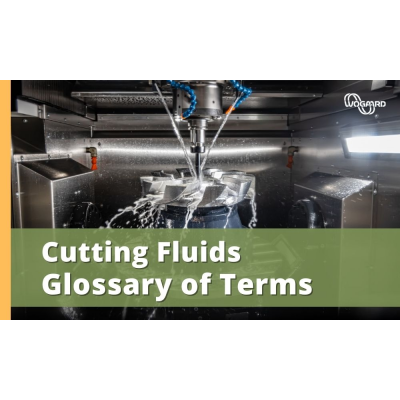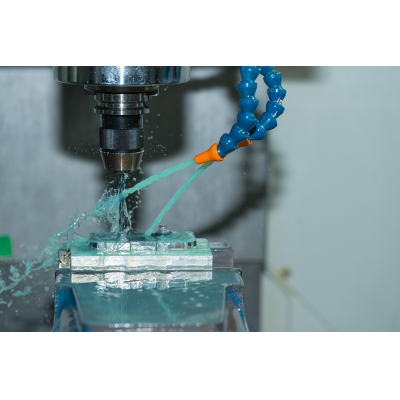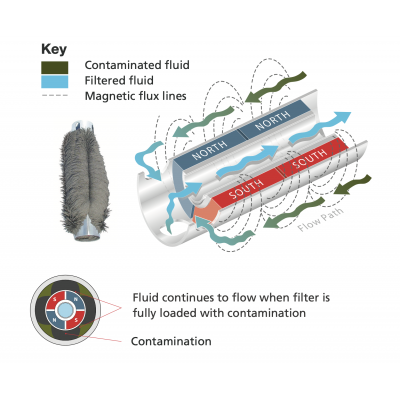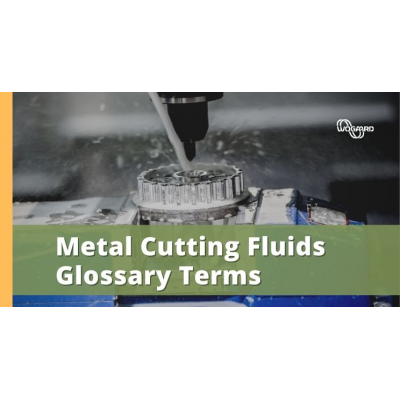
cutting fluids wogaard
Glossary of Terms: Cutting Fluids
- Alkaline: Pertaining to having a pH greater than 7.0; sometimes called caustic.
- Ammonia: A gas (NH3) comprised of nitrogen (N) and hydrogen (H) that has solubility in water ; can be formed when specific bacteria biodegrade certain amines into ammonia and water; the ammonia can be released into the air creating worker complaints.
- Bacteria: Micro-organisms that live in the air, soil, and water that can infect a metalworking fluid; the infection creates problems as the microorganisms consume various product components; bacteria are typically less than 1 micron in size.
- Bactericide: A Federally controlled substance that predominately kills bacteria.
- Biocide: A Federally controlled substance that kills both bacteria & fungi.
- Biofilm: A gelatinous mass of bacteria and/or fungi that deposits a film on a solid surface.
- Boundary: Lubricant A polar molecule that aligns itself with the metal surface to create a “cushion” of lubrication; esters, fatty acids and fats are commons boundary lubricants.
- CFU/ml: Acronym for colony forming unit/ml; a measure of microbiological growth.
- COC: Abbreviation for Cleveland Open Cup; laboratory device used to determine the flash point of a fluid above 212°F (100°C).
- Chelate: A chemical process that binds specific metals to the chelating agent; a common chelating agent is EDTA (ethylene diamine tetraacetic acid) used to bind calcium and magnesium ions in solutions to “soften” water.
- Chloride: A negative ion (anion) of chlorine typically found in most water supplies; prone to creating corrosion in higher concentrations in aqueous applications.
- Chlorine: A compound of chlorine atoms; typically used to provide extreme pressure lubrication in the form of a chlorinated compound like chlorinated paraffin.
Coolant: Fluid used to remove heat from an application; in metalworking, coolants are the water-soluble fluids like soluble oils, semi-synthetics and solutions. (See Coolant Saver) - Corrosion: The chemical process where a metal is oxidized to a different state making the metal more susceptible to rust; the metal substrate shows signs of pitting to some degree.
- Cutting Fluid: Description for a metal removal fluid used in a machining or grinding application; this covers straight oils and all ranges of water-soluble fluids.
- DI: Abbreviation for deionized, as in DI water; DI water has no hardness or conductivity because it contains no ions.

Machining cutting fluids
- Dipslide: Any type of plastic paddle that holds a surface of agar that is dipped into a used metalworking fluid to determine the presence of microorganisms; usually one side of the paddle detects bacteria while the other detects fungi.
- EP: Abbreviation for extreme pressure; EP additives are forms of sulfur, chlorine and phosphorus that are activated under extreme pressure situations where heat is created.
- Emulsion: Two fluids that are immiscible (i.e. not mixable) that are intimately dispersed in one another with an “oil” particle size that is greater than 0.10 microns.
- Endpoint: The completion of a titration; usually marked by reaching a specific pH (potentiometric) or color change with an indicator (colorimetric); see titration & indicator.
- Ester: An organic compound that is created by a chemical reaction between an alcohol and an acid; an ester is polar and provides boundary lubrication; esters can be man-made or natural.
- Falex “Block on Ring” Tester: Laboratory test method used to assess and compare lubrication qualities of metalworking fluids. A ring of metal rotates while a block of metal is applied to the outer diameter of the rotating ring; a scar is produced on the block and is measured as part of the analysis.
- Filtration: A physical separation of solids from liquid; positive filtration utilizes filter media (paper, cartridges, belt, etc.) or other physical elements (magnet, conveyor, etc.); passive filtration is achieved without media (centrifuge, cyclone, etc.). (See MagSaver kit)
- Foam: Emulsified air; the result of excess turbulence or detergency with a metalworking fluid.
- Fungi: A micro-organism that is found in the soil and air and tends to live around the metalworking fluid; fungi consists of both yeast and mold and is larger than bacteria (about 2-10 microns); usually seen in splash areas rather than in the metalworking fluid itself.
- Fungicide: A Federally controlled substance that predominantly kills fungi HLB Abbreviation for hydrophile-lipophile balance; a numeric value (0-20) assigned to emulsifiers and surfactants (see hydrophilic & lipophilic for more details) to provide information regarding the emulsification properties of the chemical.
(cutting fluid)

Magnetic filter cutting fluids
- Hardness: Related to water quality and is made up of the calcium (Ca) and magnesium (Mg) content expressed as PPM of calcium carbonate (CaCO3).
- Hydrodynamic: The simplest form of lubrication; a simple liquid film that provides a temporary cushion between two moving surfaces.
- Hydrophilic: Having a water-loving characteristic or quality; hydrophilic compounds are more water soluble.
- Indicator: Specific fluid used in very small quantities in a colorimetric titration that creates a colour change when the endpoint is reached.
- Invert: As in invert emulsion; this would be a water in oil emulsion (W/O) that is created when water is added to product concentrate instead of the other way around.
- Lipophilic: Having an oil-loving characteristic or quality; lipophilic compounds are more oil soluble.
- Lubricant: Any fluid that reduces friction between moving surfaces.
- Micelle: Technical name for the grouping of surfactants; often used when describing the emulsification of the oil droplets in an emulsion.
- Micron: A measurement of length designated by the Greek letter mu (μ); one micron is equal to one micrometre (μm), 0.001 millimetres or 0.000039 inches.
- O/W: Oil in water emulsion; see emulsion.
- PAH: Polycyclic aromatic hydrocarbon; this is the multi-ringed hydrocarbons found in base oils during the refining process; some are known to be carcinogens; PAHs are eliminated via solvent extraction or severe hydro-treatment.
- PMCC: Pensky-Martens Closed Cup; laboratory device used to determine the flash point of fluids which flash below 212° F (100°C).
- PNA: Poly-nuclear aromatic; see PAH.
- PPB: Parts per billion; one PPB is equivalent to one millilitre in 251,000 gallons.
- PPM: Parts per million; one PPM is equivalent to one millilitre in 251 gallons.
- PPTH: Parts per thousand.
(cutting fluid)

recycling cutting fluids
- Particle Size (emulsion): Size of oil droplets, or that which is being emulsified, in water usually measured in microns; this “particle” is not a hard particle, like a grain of sand, but is porous and can be disrupted or broken down.
- Particle Size (solid): Size of dirt and debris when extracted from dirty fluid via some form of positive filtration; often used in filter patch tests to describe the weight of dirt filtered at a specific micron size. (See Eclipse Magnetics Filtration)
- Plate Count: The microbiological method employed to assess growth of microorganisms in a used metalworking fluid; must be conducted in a laboratory under sterile conditions; individual colonies are counted (see CFU/ml) after the plates (petri dishes) are incubated.
- pH: The logarithmic scale for determining acidity (less than 7.0) or alkalinity (greater than 7.0) of a water containing fluid with 7.0 being neutral.
- Polymer: A chemical compound containing a repeating unit of a particular base unit (i.e. monomer); many solution synthetics utilize this technology for lubrication; while there are some natural polymers, most of this technology is a synthetic, man-made chemical.
- Premix: The action of mixing a water-soluble concentrate with water in order to create a stable mixture under controlled conditions prior to going into the main clean tank.
- RO: Abbreviation for reverse osmosis; RO is used to treat water to remove ions and is often used in conjunction with and after water has been passed through deionization (DI).
- Rancidity: The biodegradation of coolants by microorganisms growing in the fluid typically acknowledged by strong obnoxious odours.
- Refractometer: An optical device used to determine the concentration of aqueous mixtures.
- SUS: Abbreviation for Saybolt Universal Seconds; a measure of viscosity.
- Semi-synthetic: Metalworking fluid that contains some oil but has a small enough fluid particle size to be considered a micro-emulsion (less than 1.0 microns); a semi-synthetic is typically translucent in appearance when diluted in water.
- Soil load: A measurement of finely dissolved dirt and particles in a metalworking fluid; this can be determined via centrifuge or via filtration of a fixed volume of fluid.
- Soluble oil: Metalworking fluid that contains oil and emulsifiers and creates an emulsion when added to water; a soluble oil is typically milky in appearance when diluted in water.
- Solution: A mixture in which the fluid is immediately and completely soluble in water; a solution has no fluid particle size, contains no oil and is clear in dilution; sometimes called solution synthetic.
(cutting fluid)
- Stain: A chemical process similar to corrosion that produces slight imperfections of the metal surface; can typically be chemically removed without extreme damage to the metal substrate.
- Straight oil: Metalworking fluid that is used as received; typically contains oil with a variety of additives.
- Sulfate: Anegative ion (anion) typically found in most water supplies; prone to creating corrosion in higher concentrations.
- Surfactant: An acronym for surface active agent; surfactants provide wetting and detergency.
- TDS: Abbreviation for total dissolved solids; a measurement of ions (dissolved chemicals) in solution usually expressed as microSiemens or micromhos.
- Titration: A simple acid-base reaction conducted to determine an alkalinity or acidity of a fluid; the method is employed to determine concentration of an unknown.
- Tramp: oil A liquid contaminant that gets into a metalworking fluid and creates problems; sources are hydraulic oils, spindle oils, way lubricants, rail lubricants and gear lubricants; incoming parts can carry in corrosion preventives or cutting oils as tramp oil; these fluids can cover the surface of the metalworking fluid, cutting off the air supply, permitting bacteria to grow.
(cutting fluid)

cutting fluid terms